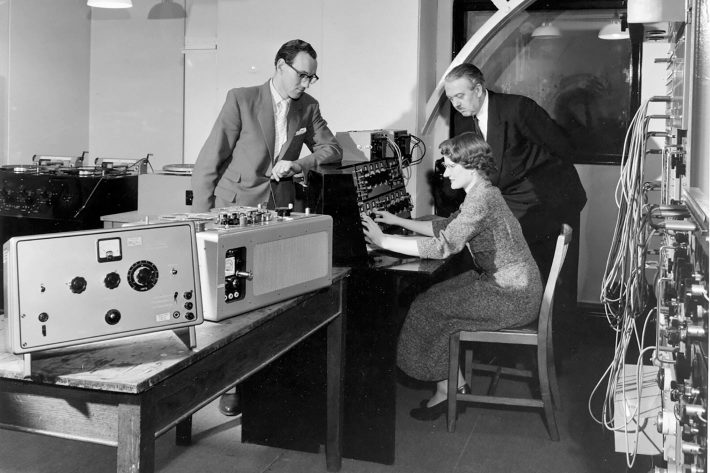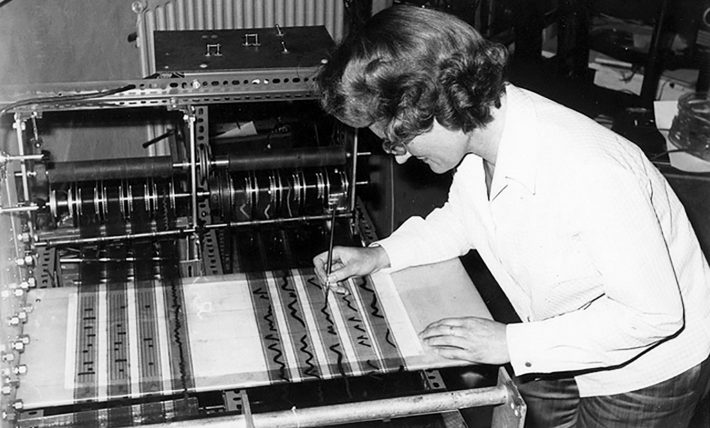We are celebrating Women’s History Month by looking back at the remarkable lifelong achievements of Daphne Oram, a true pioneer of early electronic music.

Who Is Daphne Oram?
Daphne Oram (1925 – 2003) is one of the central figures in developing British experimental electronic music. Her story is fascinating!
Besides being a musical innovator, Daphne Oram was the first woman director of a music studio, the first woman to set up a personal electronic music studio, and the first woman to design an electronic musical instrument.
Oram has many distinguished achievements. However, she is mostly known for developing a new form of optical sound synthesis in the early 1960s called Oramics. This innovative method of music composition and performance generated sounds by drawing shapes on film stripes fed through a machine and converted into sound on magnetic tape. It was an original way to think about sound creation.
Early Career at BBC
Oram’s musical journey began in the late 1930s while studying piano, organ, and composition at the Sherborne School for Girls. Then in 1943, she received an invitation to continue her education at the Royal College of Music. However, she declined to accept a position as Junior Studio Engineer and “Music Balancer” at the British Broadcasting Corporation. During this period, she became fascinated with the developments in synthetic sound and experimented with tape recording machines. She would record sounds onto tape and then cut, splice, loop, adjust the speed, and play them backward to create new sounds.
https://youtu.be/NNaqvAH7R34
Spending late nights in the BBC studios, Oram also dedicated time composing music. She composed an orchestral work entitled Still Point. Still Point was an innovative piece performed with three 78rpm discs and five microphones. Many consider Still Point to be the first composition that combined acoustic orchestration with live electronic manipulation. Oram submitted the piece to BBC for the Prix Italia award, but they rejected it. Lost to the BBC’s archives, Still Point remained unheard for 70 years. In 2016, the London Contemporary Orchestra brought this early masterpiece to lite and performed Still Point for the first time.
Advancements in Music Technology
By the 1950s, Oram had worked her way up to becoming BBC’s Music Studio Manager. Shortly after, she visited the RTF studios in Paris and became inspired by an experimental composition technique called musique concrète. Musique concrète was a revolutionary sampling technique developed by the French composer Pierre Schaeffer at the Studio d’Essai. Using advanced tape-recording technology of the time, composers would record, manipulate, and arrange various natural sounds on tape to produce a montage of sounds.
[yuzo]
Oram returned with this new knowledge and petitioned for the BBC to invest in similar technology. The company eventually acquired their first Ferrograph tape machines, one of the earliest consumer mono reel-to-reel recorders. Once again, Oram spent late hours experimenting with the equipment in creative ways. She built a makeshift studio using a combination of tape machines, oscillators, and a mixing desk. Through these experiments, she crafted compositions created entirely of electronic sounds.

Soon after, Oram was asked to provide electronic sound effects for various BBC programming. In 1957 things picked up when she was commissioned to compose music for BBC’s television drama, Amphitryon 38. Employing tape recorders, a sine wave oscillator, and some self-designed filters, she created the first synthetic score in BBC history.
That same year, Oram partnered with her BBC colleague Desmond Briscoe. Desmond was also a pioneering sound engineer that brought electronic music to radio and television. The two composed electronic music for BBC’s most significant productions of the time. Their innovative sounds captured public attention and highlighted the potential for electronic sound effects in radio and television.
BBC Radiophonic Workshop
Demand grew for new “radiophonic” electronic sounds, and the BBC finally agreed to finance a new facility devoted to producing electronic content. With the new budget, Oram and Briscoe established the renowned BBC Radiophonic Workshop in early 1958.
Oram once again made history as the first woman director and co-founder of a music studio. The BBC Radiophonic Workshop became a pioneering studio for electronic music and tape-manipulation techniques. The studio flourished from 1958 until 1998 and primarily created sound effects and incidental music for radio and television. The studio was best-known for producing acclaimed scores for programs such as “Doctor Who” and the “Quatermass and the Pit.” They also provided scores for numerous radio shows such as “The Goon Show” and “The Hitchhiker’s Guide to the Galaxy.”

However, Oram’s tenure at the workshop was short lived. In 1959, she resigned from the BBC, frustrated by the network’s continued refusal to push electronic music into the foreground. Shortly after, she assembled her own studio called the Oramics Studios for Electronic Composition. Oram would be the first woman to have ever opened her own music studio. She continued preliminary work on graphical sound techniques which led to developing a graphical sound generating system known as Oramics.
Oramics Machine
Daphne Oram’s innovative Oramics Machine is one of the earliest forms of electronic sound synthesis. It was also a breakthrough in optical synthesis technology.
The Oramics design consisted of a large rectangular metal frame, which provided a table-like surface traversed by ten synchronized strips of 35mm film strips. Oram would draw shapes on the film, which were then read by photo-electric cells and converted into sound. The generated electrical charges from the shapes also controlled the amplitude, timbre, frequency, and duration of sounds. The output from the machine was monophonic. However, recording sounds to multitrack tapes would create polyphonic textures.
Shapes interpreted by a machine and then converted into sound was an extraordinary approach to music production. In 1968, Oram recorded the first composition using the machine, entitled “Contrasts Essonic.”
Continued Career
Throughout the remainder of her career, Daphne Oram made significant advances in the electronic music movement. She continued her research and successfully developed innovative technology that helped lay the foundation for modern electronic music production.
Oram also collaborated with several film composers. She provided soundtracks to various forms of audio and visual mediums. She even provided the prominent electronic sounds for the famous James Bond film “Doctor No” in 1962.
Later on, Oram abandoned composition to devote all of her focus to advancing Oramics. In 1977, the Apple II personal home computer released and Oram sought to embrace the new technology. Assisted by programmer Steve Brett, the two worked on developing a software version of Oramics for the Acorn Archimedes computer. However, a lack of funding prevented this project from becoming realized.
Throughout the 1980s Oram spent time lecturing on electronic music and studio techniques. She also wrote several books. Her first book written in 1972, entitled “An Individual Note of Music, Sound and Electronics” investigates the physics of sound and the emergence of electronic music in a philosophical manner.
In the 1990s, Oram suffered several debilitating strokes and had to move into a nursing home. Sadly, Oram died in 2003 at 77 in relative anonymity. To this day, most of her music remains unavailable.